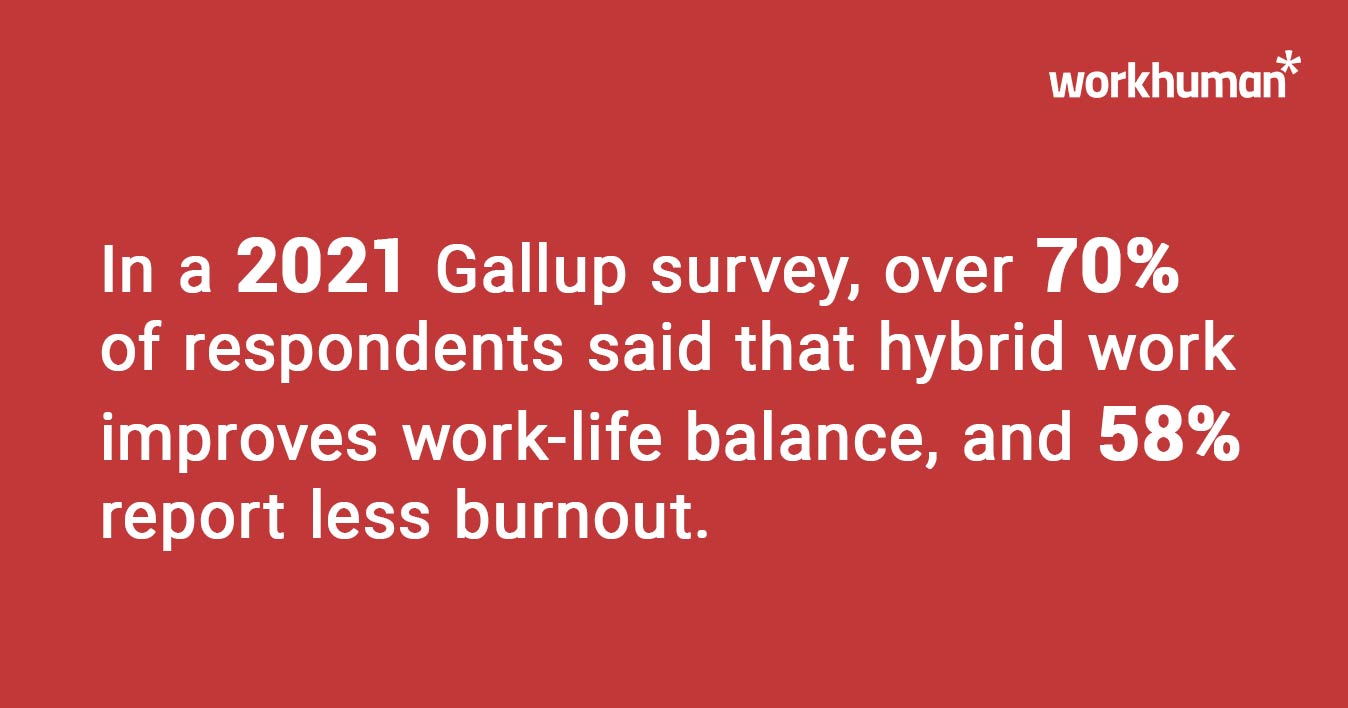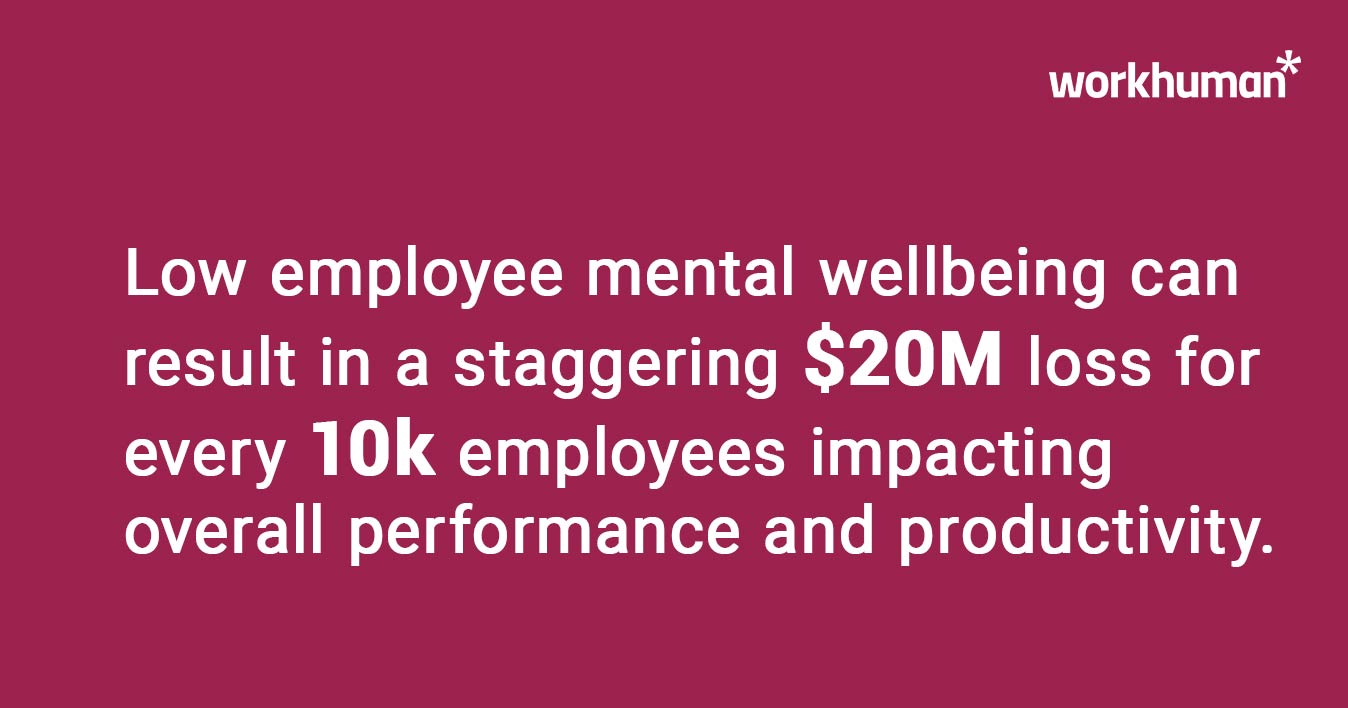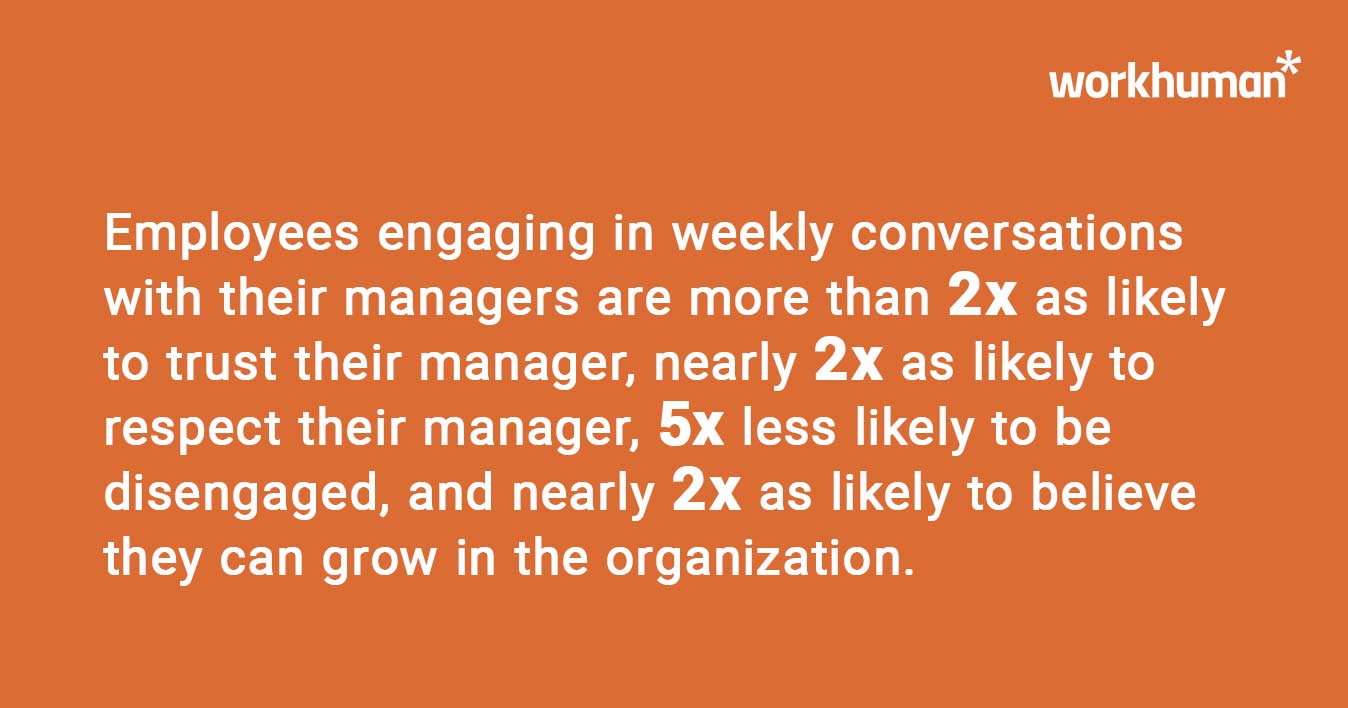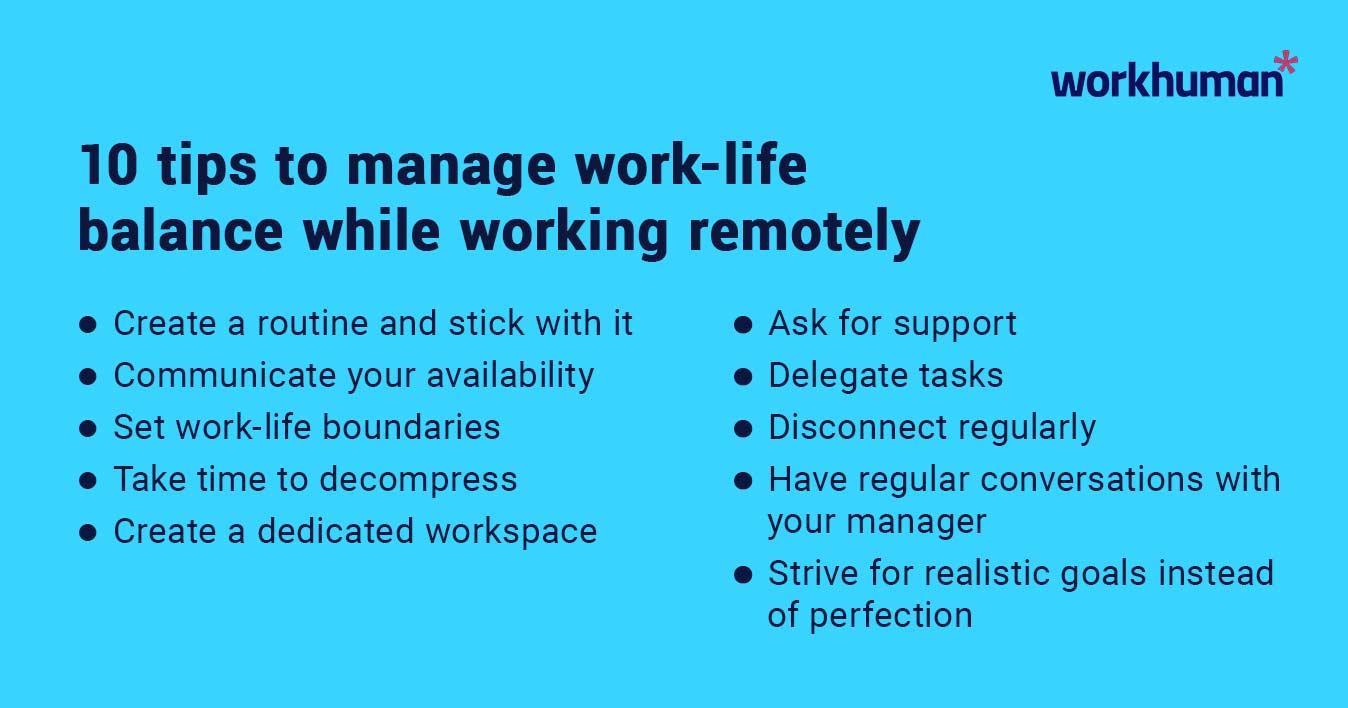Work-Life Balance Working from Home: Tips to Succeed

Working remotely has a litany of benefits: more flexibility, no commute, and greater accessibility. But managing work-life balance working from home can be difficult, with some remote workers struggling to find the line between their personal and professional lives.
That said, there are plenty of ways to manage this balance and find a fulfilling setup that works for both employees and employers alike. Let's talk about work-life balance for remote workers.
The era of remote work
It's safe to say that the 2020s are the era of remote work. The COVID-19 pandemic created more remote work than ever before, and companies and workers alike enjoyed it so much that it has become increasingly prevalent in office work.
And there's a reason why it's so popular: Over 70% of respondents in a 2021 Gallup survey said that, compared to in-office work, hybrid work improves work-life balance, and 58% report less burnout. And more than half of fully remote workers say they are very satisfied with their jobs (CNBC).
Workers enjoy the extra time that working from home affords them and find they can take more physical and mental breaks in a home office.
Why is work-life balance critical when working from home

While remote work is beloved by many, it's not without its challenges. Working from home can make achieving work-life balance difficult as the lines between personal life and work life blur. Without a good work-life balance, employees can experience more burnout and disengagement.
Employee wellness is not something to take lightly, as our recent research with Gallup has confirmed. For more insights into the benefits wellbeing can have on your workplace, check out this report.
Decreased employee engagement
It's somewhat of a myth that remote workers are less engaged than onsite ones. However, remote work can lead to higher burnoutOpens in a new tab, which can contribute to disengagement. Feelings of isolation and lack of support tend to lead to stress and burnout. This is why breaks are so important for remote workers – they help reduce burnout and lead to fewer mistakes.
Lack of work-life boundaries
Remote work can make it difficult to keep work life and home life separate. Some employees find it difficult to switch off with a lesser physical barrier between work and home, while others feel tempted to continue working beyond their normal hours simply because their computer and work are so readily available.
Mental health
Remote employees can struggle with a sense of isolation and disconnection from team members, which can lead to lower wellbeing. This isolation can exacerbate existing mental health issues and make work-life balance more difficult. For both remote and hybrid work setups, this can add up to burnout.

Burnout
Burnout can also stem from the "always-on" mentality of remote work. Many remote workers find it difficult to shut off at the end of the day since their office is so close to their home. They might find it all too easy to continue monitoring Slack over dinner and fail to take a proper break to disconnect from the day.
Is your work-life balance healthy?
When your office is mere steps from your kitchen – or maybe it's even in your bedroom – it can feel difficult to transition into your personal life at the end of the day. Remote work employees can find themselves regularly working overtime because of this.
Their personal lives bleed into their professional ones, making themselves available for far longer than they would be in a physical office, not taking enough time for themselves, and struggling with physical and mental exhaustion.
A poor work-life balance can affect the rest of your life, too. If your physical and/or mental health is struggling as a result, it can be difficult to show up meaningfully for loved ones. You might not feel you have enough time to socialize, or you might feel like you can't take your mind off work even when you are with friends.
Finding work-life balance is generally a matter of trial and error. What works for one person might not work for another. Nearly all fully remote employees need to set boundaries while working from home. Here are some tips to manage work-life balance working from home.
10 tips to manage work-life balance while working remotely
Create a routine and stick with it
Having a set routine helps create an internal clock for when you're working and when you're not. Maybe you get up and walk the dog first thing and don't open your computer until you've fed both yourself and the dog after the walk.
Maybe you take a lunch break every day at 1 P.M. (and you have that scheduled in your calendar, so no one can book a meeting over it). Maybe you block the first hour of your day to answer messages and emails. Whatever works for you, stick to it. It will help create a flow for your remote work lifestyle.
Communicate your availability
Speaking of routine, many remote workers find that set working hours are critical to good work-life balance. These hours are not only useful to set boundaries for your own working time, but they will also help your colleagues know when you're available.
Put your working hours in your Slack profile, your email signature, wherever people can easily (and often) see it so that they know when you're around. This will help prevent after-hours meetings.
Set work-life boundaries and communicate them
Similarly, whatever other boundaries you need to set to protect your personal life, you should feel empowered to set them (and supported by your company in doing so). Use collaboration tools for remote teams to share this information.
If you don't like to take meetings in the morning because that's the best time for you to focus on work, share that with your boss and teammates. If you prefer to have a phone call instead of messaging back and forth, say so!
Take time to decompress
It's crucial to find healthy ways to decompress. Taking both a mental and physical break at least once a day can do wonders to reset your focus and productivity. Even short walks (5-10 minutes) can have a measurable impact on relaxation and rejuvenation. Here are some ways to take breaks during the day or to decompress after work:
- Go for a walk
- Call a friend
- Meditate
- Do yoga or stretches
- Listen to music (a little dance break can't hurt, either)
- Sit in nature
Many remote workers find it helpful to have consistent after-work plans. That could mean heading to the gym three nights a week, meeting up with friends for dinner or trivia, or attending a class. These activities help further delineate the difference between your work life and personal life.
Create a dedicated workspace
To do good remote work, having a dedicated workspace is instrumental in creating a work zone where you get into your work mindset and step out of your home mindset. That said, not everyone has the space for a dedicated home office.
There are many ways to create a distraction-free dedicated workspace, from reconfiguring rooms to sectioning off an area. You don't have to resort to sitting on your couch or working from your bed!
Ask for support
In an office, colleagues are readily available to answer quick questions or jump in on a collaboration. Just because you work remotely doesn't mean you should lose this! Don't be afraid to ask your coworkers for support in your work.
Similarly, always ask for the help you need. If you're struggling with work-life balance, share that with your manager. You can work together to find ways to bring more balance into your everyday.
Delegate tasks
Just because you work remotely doesn't mean you're an island. Be sure to delegate tasks and collaborate just the way you would if you were in an office setting. It can be helpful to discuss delegation expectations with your manage during onboarding so you're clear on how to facilitate and manage it.
Disconnect regularly
Focus is hard in any work setting. While it can be tempting to respond to an after-hours message just because your work computer is open and you heard the ping and you "have the time," it's important to shut off from work. Respect your own working hours!
Additionally, it can be helpful to set some focused work time blocks, which can include turning off work notifications for an hour or two.
Of course, you should also take time off! Use your PTO — you've earned it, and you need a break to reset and recharge.
Have regular conversations with your manager
Regular check-ins between managers and employees are vital to a positive, open team dynamic. Check in one-on-one with your manager at least once per month to share how things are going, give updates about projects, problem-solve any issues, and share any other relevant news so that your manager is fully in the loop and can support you as best as possible. They can't read your mind and can't know what you don't tell them!

This is why it's also important to recreate "the water cooler" and facilitate casual conversation time with your colleagues. Having a weekly or monthly "meeting" where everyone just hangs out and shares whatever's on their mind can do wonders to make the team feel more connected. Plus, it helps bring out the human side of work.
Frequent, high-quality check-ins between managers and employees are essential. Learn 12 helpful tips for managers and employees to have more positive check-in experiences.
Strive for realistic goals instead of perfection
Creating a healthy work-life balance takes work. It will not happen overnight and will probably never feel "perfect." So, instead of dreaming of the perfect remote work setup, strive to set realistic goals. Think about what makes you feel productive and fulfilled on a daily basis and aim to work those elements into your daily schedule. Eventually, you'll fall into a rhythm and find what works for you.

Conclusion
By now it's clear: work-life balance is critical in remote settings. While there are some potential downsides to remote work, with a little care and intention, remote workers can thrive and be just as fulfilled in their roles as office workers.
It's important to support remote and hybrid work as a lasting change in the world of work. We've long established that there isn't just one way to work successfully, and remote work should be taken just as seriously as any other work setting.
About the author
Maeve Ginsberg
A wellness enthusiast and the mid-day walk’s #1 fan, Maeve champions work-life balance.
Having gone from a corporate job to self employment, Maeve has lived through countless working styles. This evolution forced confrontation of her own limiting beliefs, eventually breeding a completely individualized approach to work and productivity.
As a Senior Copywriter, Maeve often writes on workplace wellbeing and strives to advocate for all workers and leaders to find small yet significant ways to make their work lives healthier and more fulfilling.
Offline, Maeve enjoys testing new cuisines and hanging upside down off walls (also known as bouldering).